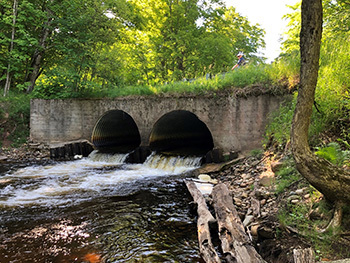
|
Construction will improve fish passage and control sea lamprey
Work on a new bridge and sea lamprey control barrier on the Sucker River in northern Alger County is set to begin this month.
“This two-stage project along Alger County Highway 58 that will improve stream health and connectivity consists of installing a new bridge and an upstream seasonal sea lamprey barrier, which will have myriad benefits for the fishery,” Cory Kovacs, Michigan Department of Natural Resources Lake Superior Unit Manager, said.
Several organizations have come together to implement this project, including the DNR, U.S. Fish and Wildlife Service, Great Lakes Fishery Commission, Alger County Road Commission, Burt Township, Superior Watershed Partnership, Green Watershed Restoration, Beaver River Consulting and Sanchez Engineering.
This $2.35 million project received funding from the Great Lakes Fish and Wildlife Restoration Act, Great Lakes Restoration Initiative, National Fish and Wildlife Foundation Sustain Our Great Lakes program, Great Lakes Fisheries Trust and the DNR’s Fisheries Habitat Grant program.
The first phase of the project will replace two culverts at the Sucker River/H-58 road crossing with a free span bridge. The existing culverts are undersized, resulting in erosion of the stream banks. The erosion increases sedimentation in the river, degrading water quality for fish and other aquatic species.
In addition, the perched culverts, which hang above the water on the downstream end, prevent fish passage for many species unable to make the jump, like brook trout and suckers. However, while preventing passage for those species, the culverts only serve as a partial barrier to sea lamprey — an invasive species that parasitizes lake trout and other fish in the Great Lakes.
Sea lamprey migrate upstream in numerous Great Lakes tributaries to spawn. Lamprey barriers are one of several means employed to control sea lamprey populations, including dispensing lampricide in streams and capturing and sterilizing male sea lamprey.
Replacing the culverts with a bridge will allow fish, including the eponymous longnose and white (common) suckers, brook trout, brown trout, rainbow trout (steelhead), coho salmon and Chinook salmon to move upstream to ideal spawning habitat, increasing their natural reproduction.
The bridge will also restore natural stream function to the downstream reaches of the river, improving movement of woody material and sediment in the system and reducing erosion of the stream banks.
During the second phase of the project, a seasonal sea lamprey barrier will be constructed farther upstream. This new lamprey barrier will stop the advancement of sea lamprey, allowing seasonal fish passage around the structure when lamprey are not spawning.
Constructing this barrier will also eliminate the need for lampricide treatments in 95 miles of upstream spawning habitat, reducing costs and labor for sea lamprey control on the river, which can be difficult to access for treatment.
“A common challenge in restoring altered Great Lakes fish and wildlife habitats to more natural conditions is the trade-off between benefiting target species and consequences associated with invasive species movement into restored habitat,” said James Farquhar, Proposal Review Committee chairman for the Great Lakes Fish and Wildlife Grant Program. “The Sucker River, H-58 road crossing and seasonal sea lamprey barrier project addresses both. We are pleased to see this worthwhile project move forward with the support of Great Lakes Fish and Wildlife Restoration Act funds."
Construction for the first phase of the project is expected to take approximately 12 weeks, beginning June 2. During this time, a detour will be in place. Work on the second phase of the project is expected to take place in summer 2026.
Learn more about this and other projects supported by Fisheries Habitat Grant funds at Michigan.gov/DNRGrants.